Esher: Difference between revisions
Adding material |
→History: Claremont |
||
| Line 45: | Line 45: | ||
In the 16th century, King Henry VIII used the area as a royal hunting ground, and the town remained wealthy. Clive of India built the Claremont mansion, and this later became a royal residence used by Queen Victoria. Prince Leopold of Saxe-Coburg lived there until he became King of the Belgians. Queen Victoria lent the house to the exiled French King Louis-Philippe and his consort Queen Marie-Amalie after the revolution of 1848. The Orléans Arms is named in their honour | In the 16th century, King Henry VIII used the area as a royal hunting ground, and the town remained wealthy. Clive of India built the Claremont mansion, and this later became a royal residence used by Queen Victoria. Prince Leopold of Saxe-Coburg lived there until he became King of the Belgians. Queen Victoria lent the house to the exiled French King Louis-Philippe and his consort Queen Marie-Amalie after the revolution of 1848. The Orléans Arms is named in their honour | ||
==Claremont== | |||
[[File:Claremont Belvedere.jpg|right|thumb|200px|The Belvedere]] | |||
The Claremont estate lies at the southern edge of Esher and West End. It is now divided between Claremont Park, owned by the [[NTE|National Trust]] and Claremont Fan Court School, which owns the Mansion and its extensive grounds. | |||
The first house here was built in 1708 by and for Sir John Vanbrugh, the architect of Blenheim Palace and Castle Howard. In 1714 he sold the house to Thomas Pelham-Holles, Earl of Clare, later Duke of Newcastle; the wealthiest and perhaps most influential politician of the age. He commissioned Vanbrugh to return and add two great wings to the house and to build a fortress-like turret, the Belvedere, on an adjoining knoll from which he and his guests could admire the views over the Surrey countryside and as far as Windsor Castle and St Paul's Cathedral. As he was Earl of Clare, he named his seat "Clare-mount", later contracted to Claremont. | |||
The Duke of Newcastle died in 1768 and his widow sold the estate to Robert Clive, ("Clive of India"), who had the house demolished and replaced by the current mansion. He also commissioned Lancelot "Capability" Brown to design the beautiful landscaped garden. The gardens, now in the hands of the National Trust<ref>[http://www.nationaltrust.org.uk/main/w-vh/w-visits/w-findaplace/w-claremontlandscapegarden/ Claremont Landscape Garden]</ref> are now enjoyed today by local people and visitors; a visit to the gardens with picnic basket in hand is a popular summer's activity. | |||
==Status in the media== | ==Status in the media== | ||
Latest revision as of 23:10, 4 June 2011
| Esher | |
| Surrey | |
|---|---|
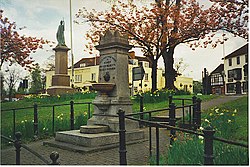 Fountain on Esher High Street | |
| Location | |
| Grid reference: | TQ145645 |
| Location: | 51°22’9"N, 0°21’54"W |
| Data | |
| Population: | 8,387 |
| Post town: | Esher |
| Postcode: | KT10 |
| Dialling code: | 01372 |
| Local Government | |
| Council: | Elmbridge |
| Parliamentary constituency: |
Esher and Walton |
Esher is a prosperous town or village in northern Surrey. It stands on a hill above the River Mole. Esher is largely suburban in character, home to commuters and the well-to-do.
The village's main axes are the Portsmouth Road, containing the High Street on which are its main shops, and meeting it the residential roads, Lammas Lane from the west and Claremont Lane from the south. Esher railway station runs to London Waterloo, providing a route for the many commuters who live in Esher.
Moore Place, on the outskirts of Esher is now a bar and restaurant. The Moore Place Estate remains a private estate.
Sandown Park Racecourse lies in the town, stretching along the Portsmouth Road.
Esher lies within the hundred of Elmbridge. The local newspaper is the Esher News and Mail.[1]
Churches
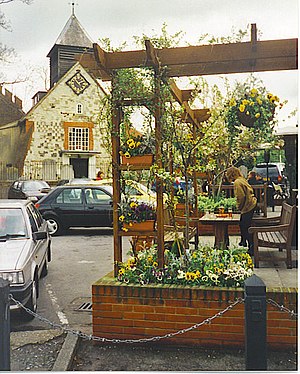
- Church of England:
- Christ Church – the parish church
- St George's Church – Esher's oldest public building, built in 1540, the former parish church, now used for occasional services and in the care of the Churches Conservation Trust
- Baptist: Esher Green Baptist Church
- Cornerstone
Markets
There is a local farmers market held on one Saturday every month, moving forward one week each month. Vendors from all over Surrey sell locally sourced produce.
West End
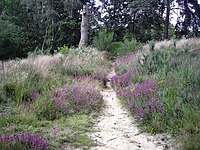
West End is a separate village south-west of Esher on the River Mole. It is gathered around a large village green with two ponds, and meadows running down to the river, used for public recreation. The main farmland of Esher is in and around West End. In West End is the woodland of "Horseshoe Clump", which becomes Esher Common.
History
Esher first appears in writing in a charter of King Ethelred I of 911, as Æsceron. In the Domesday Book of 1086 it is written Aissela and Aissele. It was held partly by the Abbey of the Cross in Normandy; partly by William de Waterville; partly by Reginald; partly by Hugh do Port; partly by Odard Balistarius. Its Domesday assets were: 14 hides 6 ploughs, 2 acres of meadow. It rendered £6 2s 0d.[2]
Esher grew as a stagecoach stop on the Portsmouth Road, which was later designated as the A3, although it was bypassed in the mid-1970s, the Portsmouth Road in Esher becoming the A307.
In the 16th century, King Henry VIII used the area as a royal hunting ground, and the town remained wealthy. Clive of India built the Claremont mansion, and this later became a royal residence used by Queen Victoria. Prince Leopold of Saxe-Coburg lived there until he became King of the Belgians. Queen Victoria lent the house to the exiled French King Louis-Philippe and his consort Queen Marie-Amalie after the revolution of 1848. The Orléans Arms is named in their honour
Claremont
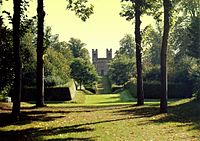
The Claremont estate lies at the southern edge of Esher and West End. It is now divided between Claremont Park, owned by the National Trust and Claremont Fan Court School, which owns the Mansion and its extensive grounds.
The first house here was built in 1708 by and for Sir John Vanbrugh, the architect of Blenheim Palace and Castle Howard. In 1714 he sold the house to Thomas Pelham-Holles, Earl of Clare, later Duke of Newcastle; the wealthiest and perhaps most influential politician of the age. He commissioned Vanbrugh to return and add two great wings to the house and to build a fortress-like turret, the Belvedere, on an adjoining knoll from which he and his guests could admire the views over the Surrey countryside and as far as Windsor Castle and St Paul's Cathedral. As he was Earl of Clare, he named his seat "Clare-mount", later contracted to Claremont.
The Duke of Newcastle died in 1768 and his widow sold the estate to Robert Clive, ("Clive of India"), who had the house demolished and replaced by the current mansion. He also commissioned Lancelot "Capability" Brown to design the beautiful landscaped garden. The gardens, now in the hands of the National Trust[3] are now enjoyed today by local people and visitors; a visit to the gardens with picnic basket in hand is a popular summer's activity.
Status in the media
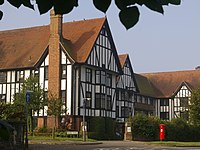
Esher has been presented in some parts of the media as a particularly middle class part of suburbia.
Monty Python referred to Esher at least three times. In episode 9 Terry Jones dressed as an 'African Native' said: 'Full frontal nudity? Not in this part of Esher.' In episode 31, a tourist played by Eric Idle complaining about package holidays ranted about 'middle-class stockbrokers' wives busily buying identical holiday villas in suburban development plots just like Esher, in case the Labour government gets in again…' Then in episode 36, a character played by Michael Palin was complaining about a rare disease that affected his use of language and stated: 'It's so embarrassing when my wife and I go to an orgy.' John Cleese's character responded: 'A party?!' To which Palin responded: 'No, an orgy. We live in Esher.'
Esher was often referred to in The Good Life by Margo Leadbetter as both a place to aspire to after Surbiton and somewhere where behaviour was more lax.